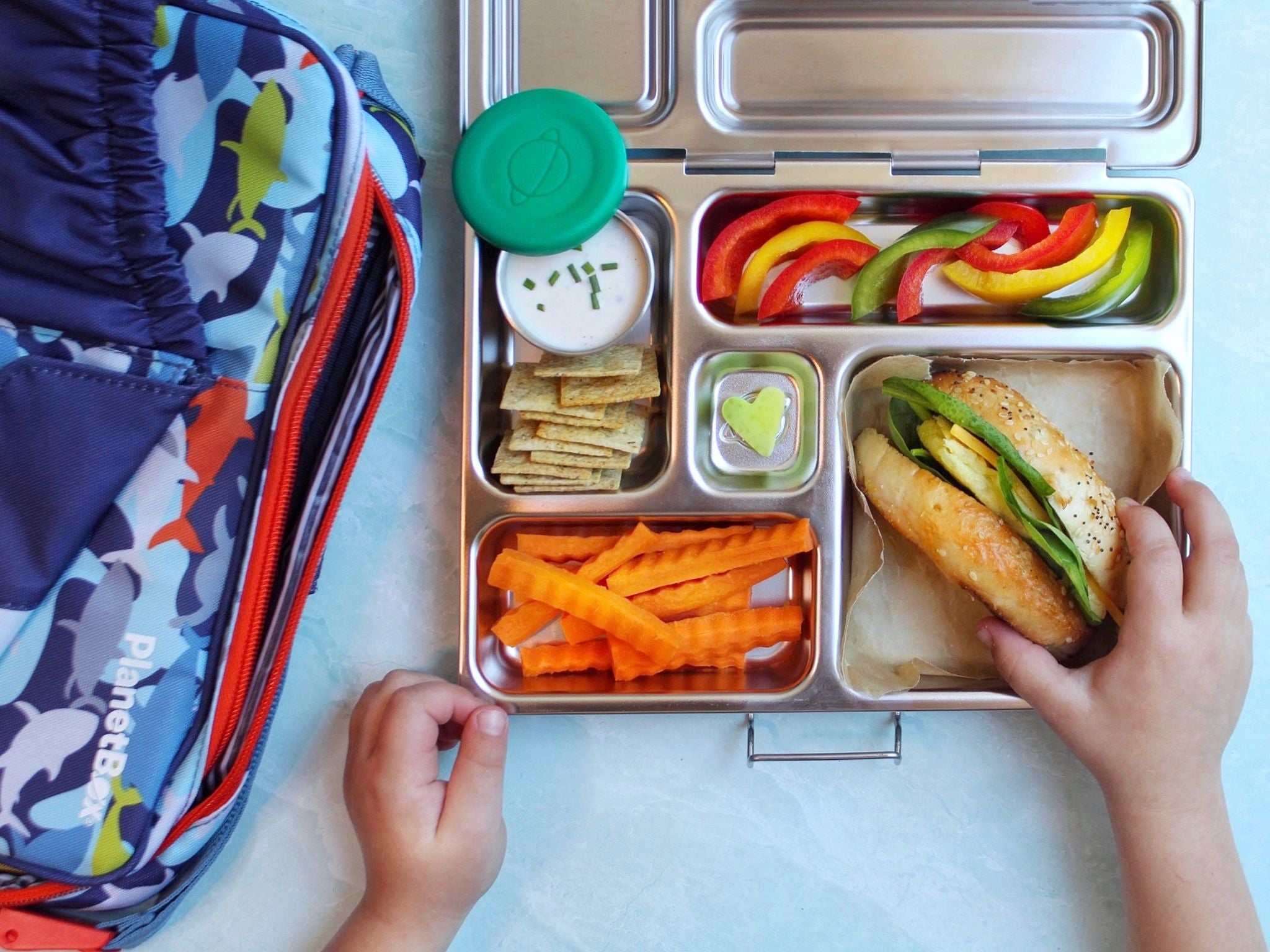With all the uncertainties in the world right now, establishing rhythms and routines for meal planning, mealtimes, and food exposure for kids are incredible ways to bring consistency to the chaos of life. We asked Registered Dietitian Noelle Martin to share her best tips for the busy fall season and how you can keep up with a good meal and grocery routine.
One of the things that can add stress to any routine is feeling rushed. Here are a few tasks that you can do to make your mealtimes easier:
1) Preparing lunches in the evening when you are cleaning up after supper. Whether your child is learning from home or at school, having this task done ahead of time makes for a smoother morning routine.
2) Wash and cut produce as part of your routine after coming home from the grocery store. Having fruits and vegetables ready to eat increases the likelihood of you adding them to a snack or meal.
3) Once each week make large batches of items that you can store in the fridge/freezer for quick snack/meal options such as soup, stew, muffins, and other baked goods.
THE VALUE OF AN EATING SCHEDULE, AT HOME OR AT SCHOOL
Children thrive on a wonderful balance between routines with boundaries and autonomy with choice. Because of this, setting specific times for them to eat and offering specific food choices is ideal. Whether your child is learning from home or at school, here are a few tips to equip you to nourish them well!
Meal/Snack Timing
It is ideal for parents and caregivers to decide what food is offered, when food is offered, and where food is offered. The child then decides if they will eat, and how much.
If your child is attending school, a schedule of eating opportunities will naturally be set. If your child is learning at home, try creating a set routine that you (and your children) can rely on for when you will offer food. If your child asks for food outside of set eating times, remind them that it isn’t snack/meal time, but it will be after the next activity.
Here is an example conversation:
Child: “Mommy, can I have a snack?”
Parent: “It isn’t snack time yet, but I am going to get your PlanetBox out of the fridge after our next activity. Would you like to make a craft or read a book together between now and then?
The beauty in this response is that you are letting the child know that food is not available outside of set times, but it is coming soon. You are also offering two beautiful moments for autonomy without influencing food timing or what food is offered.
1) The choice about which activity to do between before snack time.
2) What they will eat of the food you serve, how much, and in what order.
You can also honor your child’s desire for autonomy by offering a choice between two similar food choices (“Would you like an apple or a pear?”) at a meal or how a food will be served (ie. “Would you like your chili in a bowl or inside of a roasted pepper?”
Here is another example conversation:
Parent: “Please come to the table. I have a snack ready for you.”
Child: “Can I have a granola bar instead?”
Parent: “I am planning to serve a granola bar for evening snack. There are not any available right now. For this snack I have cheese cubes and crackers out already. Would you like a sliced apple or a sliced pear to go with them?
Chid: “Yay! I love apples! I would like this one please. Thank you, Mommy!”
THE VALUE OF ADDING FOOD EXPOSURE TO YOUR ROUTINE
If your child prefers to eat the same foods and is hesitant to try new foods, try adding food exposure activities to your routine. The best way to increase your child’s interest in the foods you offer is to involve them in food prep and create fun games for exposure to food outside of mealtimes.
Adding 5 minutes of food exposure outside of meals each day can greatly impact a child’s interest in touching or tasting a new food. And food exposures add up over time!
If you are homeschooling, you can use food preparation times throughout the day as part of your learning activities. Cooking together offers opportunity for:
- Several math activities such as addition, fractions, and measuring
- Practicing letter sounds, spelling, and reading when looking at a recipe
- Noticing/naming colors
- Talking about where food comes from
If your child is at school all day, these could be a weekend or after-school activity as time permits.
If you are looking for a few new recipes to make with your kids, try these Black Bean Bites, School-Safe Granola Bars, or Zucchini Chocolate Chip Cookies.
THE VALUE OF MEAL AND GROCERY PLANNING
The routines you use for meal planning can make the task much less daunting. Here are a few ideas that you may want to try to save on time, money, energy, and frustration when preparing meal and snack ideas for your family.
1) Prepare a Flex Evening Meal Plan and Grocery List (at the same time every week)
Plan for 7 evening meals that you can make over the coming week. Then, once you have your groceries in the house, decide on the exact order based on “best before” dates on perishable foods and any time constraints you anticipate.
By creating a grocery list, you are establishing intention for what you will buy and reducing the chance of impulse food choices.
Make a grocery list of the foods you need in the groupings that resemble the layout of the store. Start with the fresh produce and baked goods, then food that comes from the aisles, and finish with fridge and freezer items to ensure that they are kept as close to ideal temperature as possible. Be mindful of making your list with all ingredients you need so that you aren’t left short in the middle of a recipe.
2) Plan to “Cook Once, Eat Twice”
When creating your meal plan, see how many times you can prepare one meal and make portions of it stretch into future meals. Here are a few of my favorite ideas:
- Make pasta for supper and then send the leftovers for lunch the next day.
- Make chicken for supper and serve leftovers on pizza the next evening.
- Make hard boiled eggs and muffins on the weekend and leave extra for quick and easy breakfast options throughout the week.
3) Weekly Fridge, Freezer, & Pantry Audit
This is by far my best money saving tip! Before you go grocery shopping, take a few minutes to see what is in the house to prevent you from buying things you don’t need and remind you of what you need to use up. And if produce is getting wilted in your fridge, throw it into a big pot and make soup! This is always a welcome way to reduce waste and create a wonderful meal.
It is my hope that by adding these steps to your weekly routine will reduce stress and add fun and flavor to the fall season ahead!




Leave a comment
This site is protected by hCaptcha and the hCaptcha Privacy Policy and Terms of Service apply.